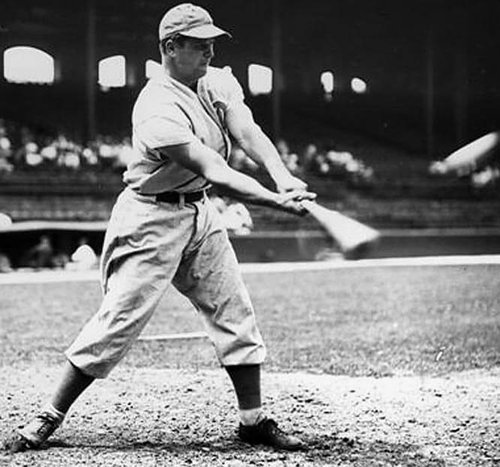The Young Jimmie Foxx: How the Farm Boy Became the Beast of Baseball
This article is based on interviews with the family and high school teammates of Hall of Famer Jimmie Foxx.
A three-time AL MVP, Foxx hit 534 home runs in his career with the Philadelphia Athletics, Boston Red Sox, Chicago Cubs and Philadelphia Phillies.
Some early box scores spelt it Fox, but the family name was Foxx for at least three generations before Jim was born.
He sometimes spelt his name Jimmy, which is how it appears on his statue in Sudlersville, Maryland. - Norman L. Macht
Learning about Jimmie Foxx from his nearest and dearest
When Jimmie Foxx’s cousin, Gladys Truitt, recalled how Jim’s father, Sammy Dell Foxx, would roll a baseball across the floor to his infant son and “Jim was so small it would knock him over,” anybody who knew the muscular Beast of baseball in his Hall of Fame playing days would have laughed in disbelief.
To them, he looked like he had been carved from an oak tree.
And if the pitchers who had to face him at the plate had known that Foxx’s boyhood idol was not Babe Ruth, but Olympic gold medalist Charley Paddock, the fastest human alive in the 1920s, they would have put up enough prize money to keep him on the oval track instead of a baseball field.
Jimmie Foxx’s early life on the farm
James Emory Foxx was born on October 22, 1907, in a wood frame farmhouse three miles outside Sudlersville – population 400 – on Maryland’s eastern shore.
His father was a catcher on the town baseball team, good enough to be professional, some said, but he stayed on the farm and played and later umpired games in the active local town-teams circuit.
Jim, as he was known to friends and family, led a typical farm boy’s life: up at 4:30, milk the cows before breakfast, walk a mile to the one-room grammar school, after school feed the livestock, get ready for milking again. In the summer, help with the plowing and cultivating.
High school was a three-mile hike.
By then Jim was hoisting milk cans onto the wagon to take to the railroad depot in town, pitching hay into the top level of the barn, cutting wheat and corn, splitting logs for firewood, swinging 200-pound bags of phosphate between platforms and wagons -- typical farm boys’ chores in those days.
But Jim was no longer a typical farm boy.
A popular contest of strength involved standing in an empty half-bushel basket, feet together with no room to move them, and lifting a 120-pound sack of wheat or corn to your shoulder.
Jim won every time. (Later, he once took hold of the ankles of a 170-pound teammate and lifted him straight up off the floor).
Jimmie’s start in school sports
By the time he was 13, he was 185 pounds of muscle on a 5-11 frame, with a cannon for an arm. He was the catcher on the high school team.
Bernard Merrick, the 95-pound second baseman, recalled, “Jim would squat down behind home plate and throw to second like a line drive without getting up. The pitcher had to duck to save his life.”
The first baseman, Ed Walraven, said, “I had a little two-dollar mitt. Jim threw so hard my hand was hurting from the first day.”
When Jim tried pitching, his fastball knocked the catcher over every time.
At bat he hit line drives so hard infielders ducked to get out of the way. Merrick recalled, “One day we had to take pre-game batting and infield practice at the same time.
I was at second base and Jim hit one over me that hissed as it went by. If it had hit me, I wouldn’t be here to tell about it.”
Jim was also the captain and center on the basketball team, at a time when a typical score was 13-8, and captain of the soccer team.
But it was as a track star that he gained statewide fame.
In 1923 he held titles in eight events. Allowed to enter only two in the annual state Olympiad, he won gold medals in the high jump and 220.
Jimmie Foxx’s personal life
In every respect, Jim was a typical rural small-town teenager of the early 1920s. He went swimming in the creek.
On Saturday nights he tagged along when the men went into town to talk outside the three stores, went into the stores to spend the nickel or dime he had earned for the week on ice cream or a bag of candy.
When he could scrape together 25 cents, he went with his friends in somebody’s Model T Ford to a bigger town that had a theater, for a movie and a banana split.
He went to taffy pulls and dances; on Christmas Eve and New Year’s Eve, they borrowed the big circle saw from the saw mill, put an iron rod through the hole and carried it around town banging on it with a hammer.
Every Fourth of July there was a picnic, a horse race and a ball game. By the age of 12, Jim was playing on the same town team as his father.
There was one other trait that emerged early: Jim had an affable, easygoing nature.
He was popular, sociable, neither shy nor showoff. He never got angry, never lost his temper, never got into a fight, even if provoked. “Nobody ever saw him mad,” his friends recalled.
Perhaps that was nature’s way of protecting the world, by combining “the strength of a gorilla with the disposition of a collie,” as one writer later described him.
